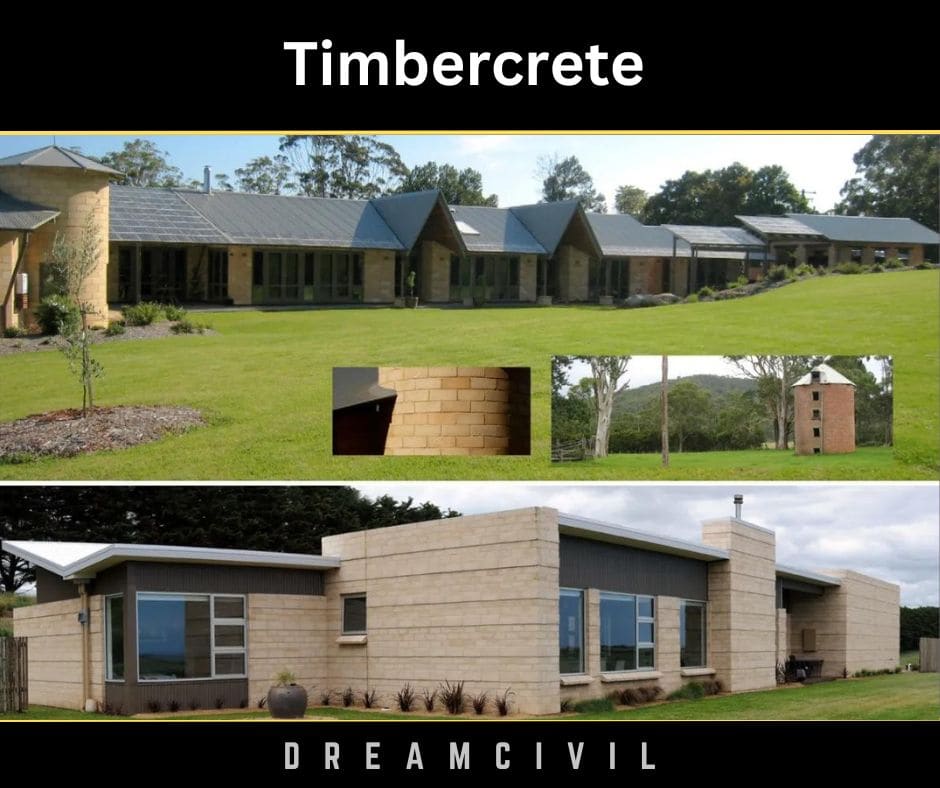Table of Contents
Timbercrete may be defined as an environmentally friendly construction product made from sawdust and concrete.
It reuses waste products and substitutes some energy-intensive parts of conventional concrete.
So far, timbercrete has been used to produce bricks, blocks, panels, and pavers and can be pressed to create an incredible array of sizes, colors, shapes, and textures.
The material sequesters carbon stores it in the building, and compensates for the emissions the polluting vehicles release.
It is lighter than concrete and possesses excellent thermal insulation, making it a perfect material for sustainable building projects. Timbercrete has also been used in the construction of homes and residential buildings.
1. Components
The components of Timbercrete are as follows:
a. Timber waste
b. Cement
c. Sand
d. Binders
e. Non-toxic deflocculating additive
2. Uses of Timbercrete
a. Residential, industrial, and commercial buildings
b. Landscaping design
c. Acoustic barriers for highways
d. Acoustic and fireproof walls for multi-story apartments
e. Cladding panels
3. Characteristics of Timbercrete
a. The density of timbercrete ranges from 900 Kg/m3 to 1500 Kg/m3.
b. Its load-bearing capacity ranges from 5 MPa to 15 MPa.
c. It is bulletproof; no bullet has penetrated through a 200 mm brick.
d. The insulation value of timbercrete is R-2.5 per 25 mm of thickness.
e. It is 2.5 times lighter than concrete and clay.
f. It has high fire resistance; a 19 cm thick timbercrete block can outperform typical concrete block, clay, timber, and steel construction.
g. It is less porous than concrete blocks and does not erode.
h. Timbercrete block resistant to airborne sound transmission is better than aerated concrete.
4. Advantages
The advantages are as follows:
a. It takes carbon dioxide, which would otherwise evolve greenhouse gases in the atmosphere.
b. Its blocks and bricks have lower embodied energy than that clay bricks.
c. The insulation value (R) of timbercrete is greater than conventional solid masonry bricks, blocks, and panels. This signifies that timbercrete homes are energy efficient throughout most of the year.
d. It is an outstanding thermal mass material that soaks and stores thermal energy and releases it gradually.
e. Timbercrete blocks and panels can be screwed and nailed fastly without failing all benefits of conventional masonry.
f. Units of timbercrete are lighter and more well-known, constructing it effortless to regulate and completing the construction process more effortless and faster.
g. Constituent materials are obtainable locally, decreasing transportation and total costs.
5. Disadvantages
The disadvantages are as follows:
a. The mixing process of timbercrete is not entirely defined as concrete, guiding to poor quality control.
b. Waste wood may influence health if mixed with other chemicals, like formaldehyde, not pointed to be together.
6. FAQ
a. How to make Timbercrete?
⇒ Here is the process to prepare:
a. Thoroughly mix the sawdust and the sand.
b. Put the cement and mix it well too.
c. Ensure the mix is a constant color.
d. Now put the water in and blend it again.
e. Put the water gradually and uniformly.
b. What is Timbercrete?
⇒ Timbercrete may be defined as an environmentally friendly construction product made from sawdust and concrete.
c. Where to buy Timbercrete?
⇒ You can buy online by searching it on Google and visiting anyone of the timbercrete provider store online.
d. How to make Timbercrete blocks?
⇒ The process of making timbercrete is similar to above one.
You will need:
a. 3 parts sawdust – Use wood – which is low in tannin, gums, and oils – for the best results
b. 2 parts sand
c. 1 part cement
e. Is Timbercrete sustainable?
f. How durable is Timbercrete?
⇒ It will last hundreds, if not thousands of years.
7. References1. Content Filter & Authenticity Checking Team, Dream Civil International (Our team checks every content & detail to maintain quality.) |
Read Also: Traffic Islands

